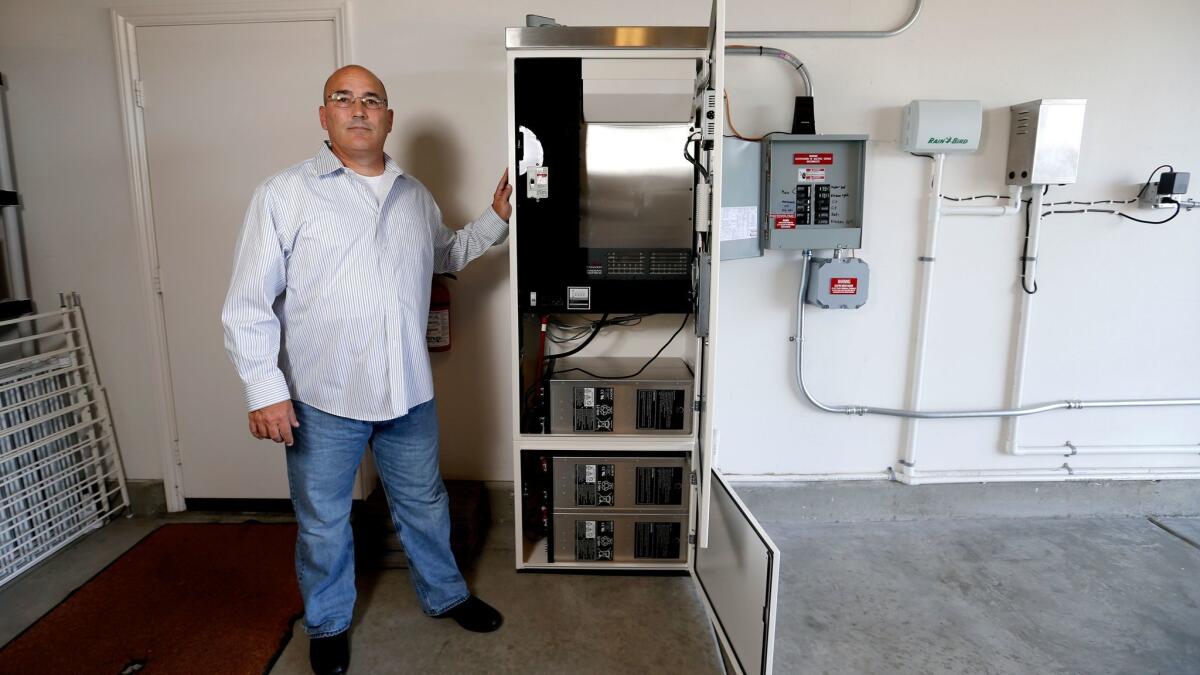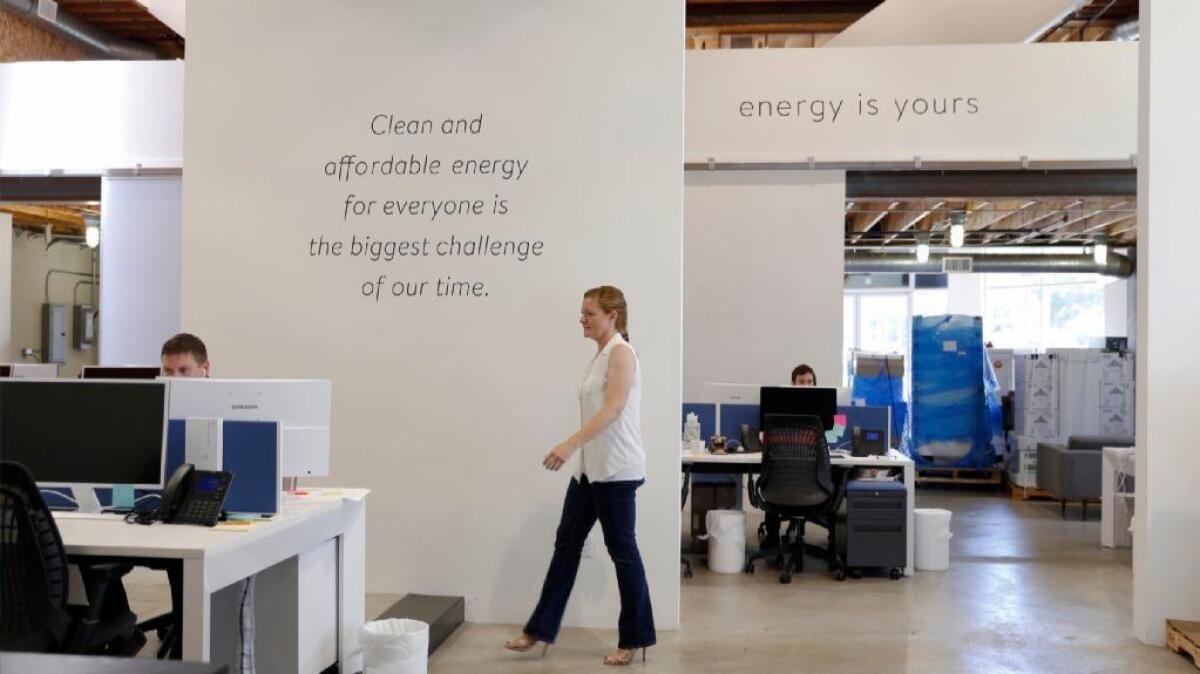Severing ties with utilities isn’t as easy as cutting the cable cord

If disaster ever struck, Joe Fleischmann could keep the lights, refrigerator and big-screen TV running in his Orange County home, even if the power company went dark.
Fleischmann is an early adopter of home energy storage: In his garage is a battery strong enough to help keep the essentials in operation.
The home of the former Los Angeles County sheriff’s deputy sports a full suite of eco-friendly power equipment — solar panels on his roof as well as battery storage and an electric vehicle charging station in his garage. But even with all his powerful tools, Fleischmann still can’t cut the power cord with Southern California Edison.
Severing ties with the centralized power system — going off the grid — might be a dream of survivalists and some consumers, but the reality is difficult to achieve. The cost of batteries large enough to power air conditioners, a washer, dryer and other big energy guzzlers would imperil most homeowners’ budgets.
“As far as being completely off grid, it’s kind of a foreign thought to me because you’ve always had to rely on the utilities,” Fleischmann said. “We could do that, but at what cost?”
Even the leader in the residential electricity storage industry — and supplier of Fleischmann’s $26,000 battery system — doesn’t see consumers defecting from their utilities.
“True off-grid is ridiculous,” said Blake Richetta, senior vice president of Sonnen Inc., who oversees the German battery maker’s U.S. arm that is based in North Hollywood. Sonnen has about 18,000 residential systems, primarily in Germany and Italy.

Not only is it costly to turn your home into a virtual power plant, Richetta said, but it makes the consumer’s home an island that would be unable to tap the central power system if the off-grid operation fails.
And going it alone negates a more global benefit: Residential and commercial power systems can provide support for the electric grid and utility companies.
“Energy storage adds value, significant value, to the grid operator,” said Richetta, a former North American sales manager for Tesla Inc., which has a battery line of its own.
For instance, as consumers add solar panels and battery storage, combined with increasing energy efficiency, demand decreases for electricity from traditional utility companies. That helps utilities avoid construction of new fossil fuel plants such as natural gas facilities.
“We are essentially helping the grid do things it could never do before in a cheaper and cleaner way,” Richetta said.
And although Fleischmann’s system comes with a high price tag, the cost has been dropping substantially, making it potentially more affordable for average consumers in the next few years.
Ravi Manghani, director of energy storage for GTM Research, said the installed price of residential systems has dropped 25% to 30% over the last two to three years. The cost of the batteries themselves has declined by about 60% during that time to about $425 per kilowatt-hour, he said.
And consumers can benefit from state and federal incentives that can reduce the overall cost, Manghani said.
In some places, living off-grid makes more sense than in others.
In the United States, that place is Hawaii, which has the nation’s highest electricity rates at roughly twice as much as what Californians pay per kilowatt-hour. Because Hawaii must import fuel for its power plants, costs run high.
Hawaii’s higher utility tab makes it a simpler decision for consumers to spring for solar panels and battery storage. And that potential sales opportunity has drawn the attention of energy companies including Sonnen, Tesla, Sunrun and Blue Planet, which are offering solar and battery packages similar to Fleischmann’s system but at various sizes.

But for other places, even relatively high-cost California, it can be difficult to get a deal that includes storage for less than what consumers are paying their utility company for electricity.
“You’re probably not going to save enough money to make that work,” said Ron Nichols, president of Southern California Edison, which serves about 15 million people through 5 million residential and business accounts. “Right now it doesn’t pencil out.”
Nichols acknowledges that the equation might improve eventually for residential consumers.
“Battery technology is going to get better over time,” he said. “And its costs are going to come down.”
Nichols said he sees some of the greatest, immediate opportunities in commercial storage systems such as at schools, large office buildings and other commercial entities.
Commercial customers pay a premium for using electricity at times of peak demand. A battery can reduce commercial customers’ use of electricity from the utility company during those periods and ultimately save money. In addition, they can contract with the power company to allow the utility to draw electricity from the battery when the electric grid might need it.
“It’s not some silver bullet for everything,” Nichols said. “But we’re finding new opportunities. They’re going to be very helpful for the grid in the future.”
Bernadette Del Chiaro, executive director of the California Solar Energy Industries Assn., agrees that battery prices are still a bit high on the residential side. But she argues that just as commercial customers can assist the electric grid with their batteries, so can residential consumers by staying connected to their utilities and the wider electric grid.
“The solar and storage industry are really, actually committed to a green grid,” Del Chiaro said. “It really is seen as making the grid stronger and more resilient, as opposed to everybody an island unto themselves.”
Del Chiaro said utility companies benefit from the argument that solar plus storage is too expensive for residential customers because they retain control of electricity and keep prices high for consumers. But working toward empowering consumers will ultimately reduce their costs, she said.
“What we’re trying to push for is something that truly transforms the market,” Del Chiaro said. “Everybody just thinks solar and storage are toys for the rich. The utilities run around Sacramento and call solar plus storage the ‘Cadillac class.’”
But if utilities are allowed to set the agenda for how the electric system develops, she said, “we’ll keep prices really high that way.”

Fleischmann, who retired from the Sheriff’s Department after a back injury, installed a 6.5-kilowatt solar array on his Brea home three years ago. He added the Sonnen battery system last year.
Fleischmann thought the Sonnen system, which looks like a storage cabinet in his garage, provided a good match for his home. The system is expandable, unlike some batteries, and can be operated from a computer and smartphone.
“I think it actually looks pretty cool,” Fleischmann, 46, said.
His goal was to save money on the electricity consumed by his family of five as well as to provide backup power in an emergency. He wasn’t thinking off-grid.
But he purchased a large battery — 12 kilowatts, while the typical home system, Nichols said, is about 4 kilowatts and enough to last about four hours. Fleishmann chose a large system with the benefit of a state rebate that picked up about a third of the cost of the battery.
Fleischmann keeps about 20% to 25% of his battery in reserve as backup while tapping the remainder to support his home or send to the electric grid.
“If the grid goes down, we would still have a source of electricity,” Fleischmann said. “I think with the popularity of the system and as the costs come down, more people will be able to invest in them.”
For more energy news, follow Ivan Penn on Twitter: @ivanlpenn
ALSO
Infiniti introduces ‘heritage-inspired’ prototype race car
The woes of this car-less worker can’t be fixed with junkers or leasing schemes
Would you fly in a pilotless commercial plane if it meant a cheaper airline ticket?







